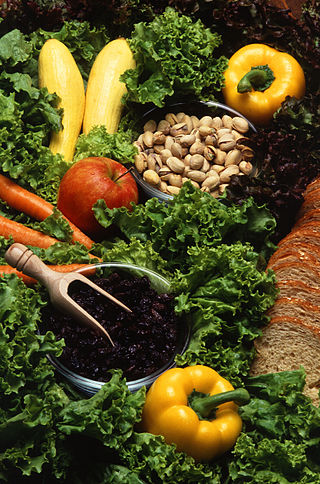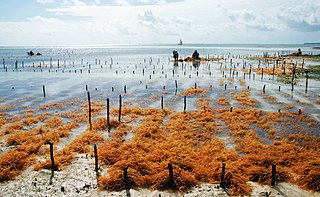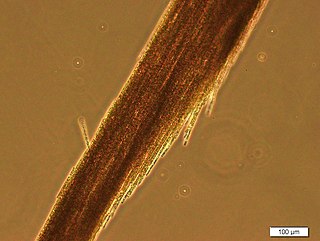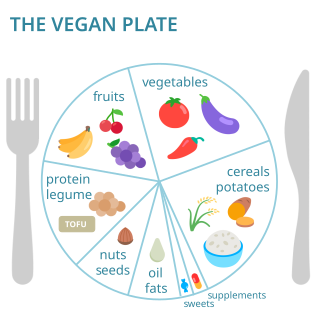
Vitamins are organic molecules that are essential to an organism in small quantities for proper metabolic function. Essential nutrients cannot be synthesized in the organism in sufficient quantities for survival, and therefore must be obtained through the diet. For example, vitamin C can be synthesized by some species but not by others; it is not considered a vitamin in the first instance but is in the second. Most vitamins are not single molecules, but groups of related molecules called vitamers. For example, there are eight vitamers of vitamin E: four tocopherols and four tocotrienols.

Taurine, or 2-aminoethanesulfonic acid, is a non-proteinogenic naturally occurred amino sulfonic acid that is widely distributed in animal tissues. It is a major constituent of bile and can be found in the large intestine, and accounts for up to 0.1% of total human body weight.

A dietary supplement is a manufactured product intended to supplement a person's diet by taking a pill, capsule, tablet, powder, or liquid. A supplement can provide nutrients either extracted from food sources, or that are synthetic. The classes of nutrient compounds in supplements include vitamins, minerals, fiber, fatty acids, and amino acids. Dietary supplements can also contain substances that have not been confirmed as being essential to life, and so are not nutrients per se, but are marketed as having a beneficial biological effect, such as plant pigments or polyphenols. Animals can also be a source of supplement ingredients, such as collagen from chickens or fish for example. These are also sold individually and in combination, and may be combined with nutrient ingredients. The European Commission has also established harmonized rules to help insure that food supplements are safe and appropriately labeled.

Chlorella is a genus of about thirteen species of single-celled green algae of the division Chlorophyta. The cells are spherical in shape, about 2 to 10 μm in diameter, and are without flagella. Their chloroplasts contain the green photosynthetic pigments chlorophyll-a and -b. In ideal conditions cells of Chlorella multiply rapidly, requiring only carbon dioxide, water, sunlight, and a small amount of minerals to reproduce.

Vegetarian nutrition is the set of health-related challenges and advantages of vegetarian diets.

Phycocyanin is a pigment-protein complex from the light-harvesting phycobiliprotein family, along with allophycocyanin and phycoerythrin. It is an accessory pigment to chlorophyll. All phycobiliproteins are water-soluble, so they cannot exist within the membrane like carotenoids can. Instead, phycobiliproteins aggregate to form clusters that adhere to the membrane called phycobilisomes. Phycocyanin is a characteristic light blue color, absorbing orange and red light, particularly near 620 nm, and emits fluorescence at about 650 nm. Allophycocyanin absorbs and emits at longer wavelengths than phycocyanin C or phycocyanin R. Phycocyanins are found in cyanobacteria. Phycobiliproteins have fluorescent properties that are used in immunoassay kits. Phycocyanin is from the Greek phyco meaning “algae” and cyanin is from the English word “cyan", which conventionally means a shade of blue-green and is derived from the Greek “kyanos" which means a somewhat different color: "dark blue". The product phycocyanin, produced by Aphanizomenon flos-aquae and Spirulina, is for example used in the food and beverage industry as the natural coloring agent 'Lina Blue' or 'EXBERRY Shade Blue' and is found in sweets and ice cream. In addition, fluorescence detection of phycocyanin pigments in water samples is a useful method to monitor cyanobacteria biomass.

Algaculture is a form of aquaculture involving the farming of species of algae.

Aphanizomenon flos-aquae is a brackish and freshwater species of cyanobacteria of the genus Aphanizomenon found around the world, including the Baltic Sea and the Great Lakes.

Spirulina is a genus of cyanobacteria. It is not classed as an algae, despite the common name of cyanobacteria being blue-green algae. Spirulina is commonly used in food, especially as a supplement for space travellers.

Vitamin B12 deficiency, also known as cobalamin deficiency, is the medical condition in which the blood and tissue have a lower than normal level of vitamin B12. Symptoms can vary from none to severe. Mild deficiency may have few or absent symptoms. In moderate deficiency, feeling tired, headaches, soreness of the tongue, mouth ulcers, breathlessness, feeling faint, rapid heartbeat, low blood pressure, pallor, hair loss, decreased ability to think and severe joint pain and the beginning of neurological symptoms, including abnormal sensations such as pins and needles, numbness and tinnitus may occur. Severe deficiency may include symptoms of reduced heart function as well as more severe neurological symptoms, including changes in reflexes, poor muscle function, memory problems, blurred vision, irritability, ataxia, decreased smell and taste, decreased level of consciousness, depression, anxiety, guilt and psychosis. If left untreated, some of these changes can become permanent. Temporary infertility, reversible with treatment, may occur. A late finding type of anemia known as megaloblastic anemia is often but not always present. In exclusively breastfed infants of vegan mothers, undetected and untreated deficiency can lead to poor growth, poor development, and difficulties with movement.

Vitamin B12, also known as cobalamin, is a water-soluble vitamin involved in metabolism. It is one of eight B vitamins. It is required by animals, which use it as a cofactor in DNA synthesis, and in both fatty acid and amino acid metabolism. It is important in the normal functioning of the nervous system via its role in the synthesis of myelin, and in the circulatory system in the maturation of red blood cells in the bone marrow. Plants do not need cobalamin and carry out the reactions with enzymes that are not dependent on it.

Edible seaweed, or sea vegetables, are seaweeds that can be eaten and used for culinary purposes. They typically contain high amounts of fiber. They may belong to one of several groups of multicellular algae: the red algae, green algae, and brown algae. Seaweeds are also harvested or cultivated for the extraction of polysaccharides such as alginate, agar and carrageenan, gelatinous substances collectively known as hydrocolloids or phycocolloids. Hydrocolloids have attained commercial significance, especially in food production as food additives. The food industry exploits the gelling, water-retention, emulsifying and other physical properties of these hydrocolloids.

Arthrospira is a genus of free-floating filamentous cyanobacteria characterized by cylindrical, multicellular trichomes in an open left-hand helix. A dietary supplement is made from A. platensis and A. maxima, known as spirulina. The A. maxima and A. platensis species were once classified in the genus Spirulina. Although the introduction of the two separate genera Arthrospira and Spirulina is now generally accepted, there has been much dispute in the past and the resulting taxonomical confusion is tremendous.

Vegan nutrition refers to the nutritional and human health aspects of vegan diets. A well-planned vegan diet is suitable to meet all recommendations for nutrients in every stage of human life. Vegan diets tend to be higher in dietary fiber, magnesium, folic acid, vitamin C, vitamin E, and phytochemicals; and lower in calories, saturated fat, iron, cholesterol, long-chain omega-3 fatty acids, vitamin D, calcium, zinc, and vitamin B12.

Microalgae or microscopic algae grow in either marine or freshwater systems. They are primary producers in the oceans that convert water and carbon dioxide to biomass and oxygen in the presence of sunlight.

Arthrospira platensis is a filamentous, gram-negative cyanobacterium. This bacterium is non-nitrogen-fixing photoautotroph. It has been isolated in Chenghai Lake, China, soda lakes of East Africa, and subtropical, alkaline lakes.
Protein quality is the digestibility and quantity of essential amino acids for providing the proteins in correct ratios for human consumption. There are various methods that rank the quality of different types of protein, some of which are outdated and no longer in use, or not considered as useful as they once were thought to be. The Protein Digestibility Corrected Amino Acid Score (PDCAAS), which was recommended by the Food and Agriculture Organization of the United Nations (FAO), became the industry standard in 1993. FAO has recently recommended the newer Digestible Indispensable Amino Acid Score (DIAAS) to supersede PDCAAS.

Avigad Vonshak is a Professor Emeritus at the French Associates Institute for Agriculture and Biotechnology of Drylands at the Jacob Blaustein Institutes for Desert Research at Ben-Gurion University of the Negev, Israel.

Chlorella vulgaris is a species of green microalga in the division Chlorophyta. It is mainly used as a dietary supplement or protein-rich food additive in Japan.

As in the human practice of veganism, vegan dog foods are those formulated with the exclusion of ingredients that contain or were processed with any part of an animal, or any animal byproduct. Vegan dog food may incorporate the use of fruits, vegetables, cereals, legumes including soya, nuts, vegetable oils, as well as any other non-animal based foods.


















